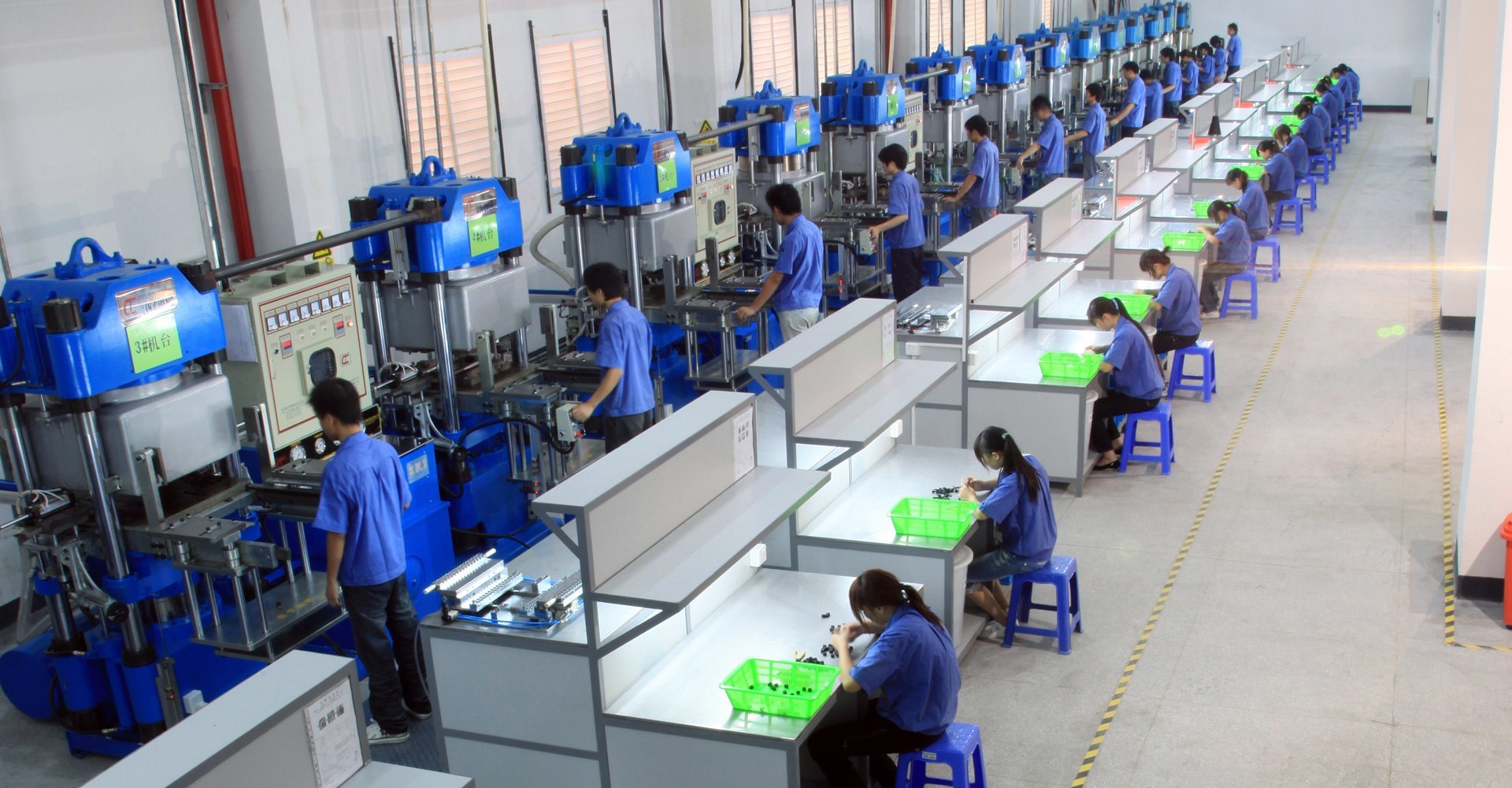LOROM’s rubber facility in Hangzhou, China with injection presses as well as transfer moulding machines is capable of producing high quality grommets and gaskets and other thermoset parts capable of meeting an unlimited amount of harsh environments.
Supported with our state of the art compounding facility enables us to design custom parts for specific application.
Our extensive R&D lab offers our customers extensive testing of materials to develop specific compounds capable of meeting specific customer requirements.
LOROM Rubber Molded Parts Processes
Injection Moulding
Injection moulding is a manufacturing process accomplished by taking raw, uncured rubber and forcing it into a heated mould using a reciprocating screw. The material is formed and cured under heat and pressure, then removed to cool as a custom shape.
Compression Moulding
Compression moulding is defined by taking a pre-measured amount of raw rubber material that is placed into a heated open lower mould cavity. The top cavity is then forced closed, causing the raw material to flow through the shape of the mould. After curing, the mould cavity is opened and the shapes can be removed.
Transfer Moulding
Transfer moulding is a form of rubber production in which the raw material is measured, heated and then forced into chamber. A plunger is used to force the material into the mould using a system of runners and channels to thoroughly fill the closed mould. The mould is heated to cure the raw material. The mould is then opened and the moulded parts can be removed.
Material Sciences
To ensure optimal performance and to meet the application requirements of our customers, our engineering staff and chemists before designing a rubber moulded product examines the relationship between the structure of materials, their properties, how processing changes them and how the materials will perform in an application.
Our capabilities include:
- Hundreds of rubber compounds
- Custom formulating in our on-site materials laboratory
- Comprehensive R&D for formulation control, new material development, supplier/material evaluations and approvals
- Advanced laboratory with compound analysis and testing capabilities
- Compound testing for product applications and their environments
- High temperature, low friction specialty fluoroelastomer compound development
- Regulatory agency approvals for: UL, ISO10993
Custom Rubber Compounding
Our many years of experience in rubber moulding and material science helps us meet and reduce the critical time to market. Our on-site chemists enable us to develop custom compounds to meet customer’s specific requirements.
In house mixing capabilities for compounds and tooling expert’s serves as an important part of the developing the manufacturing process and reduces the process cycle. Rheological and physical profiles of each batch is tested in the lab and approved before being released to production ensuring that customer requirements and performance criteria along with the associated tests critical to the application are met.
Cryogenic De-flashing
Even though we have the perfect moulding tool flash is inevitable a side effect of the moulding process, the flashes are typically found in areas where the mould comes together or apart, when the liquid mould material escapes from the mould cavity during production. No part leaves LOROM’s facility less than perfect, hence we have installed advanced Cryogenic de-flashing of our rubber and plastic parts removes unwanted residual mould flash that is found on moulded parts after removal from the mould.
LOROM’s Cryogenic deflashing does not degrade the parts or harm their finish, with only the flash removed and the shape of the part retained and is one of the most cost effective and efficient processes to remove flash.
- Parts are loaded into a stainless steel basket that is placed into the Cryogenic de-flashing equipment.
- Basket is inserted into a stainless steel tumbler, gaseous nitrogen is introduced to lower the temperature in the chamber.
- Once the desired temperature is reached, the parts are “blasted” with a cryogenic grade polycarbonate media.
- Blasting and tumbling continue for a programmed amount of time.
- Once blasting stops, the parts continue to tumble for a programmed time to remove any residual burrs that have been removed from the parts.
- Parts are emptied into a net that is suspended in a holder and blown with compressed air or submerged in water to remove any remaining media particulate.
- Parts are secured in the net and placed in centrifugal cleaner.
- Parts inspected and packed.
In House Tooling Design and Manufacturing
- Our in-house tooling design and fabrication center in our Hangzhou facility includes the design of precision tooling that is capable of manufacturing tight tolerance and high quality parts. We also only work with the best steel ensuring durability and longevity.
- To reduce time we cut and develop inexpensive prototype tools that after initial evaluation results will be implemented in the production tools.
- By producing prototype parts that are capable of passing functionality tests for the final component which is especially important in the medical device industry.
- We design and fabricate tooling for our complex parts for customers in various markets as small as .00029 grams with mass production that contains over multiple cavities to components as large as 24 inches in diameter.
Mold Flow Analysis
Mould flow analysis, MFA optimizes the mould design process, the mould and the products are designed to improve quality and reduce cost as well as time-to-market.
The MFA software allows us analyzing of thermoplastic and thermoset moulding of i.e.:
- 3D flow effects such as jetting
- Temperatures and pressures within the mould
- Prediction of defects such as flow lines and air trap
- Thermally induced residual stresses and distortion for die and inserts






